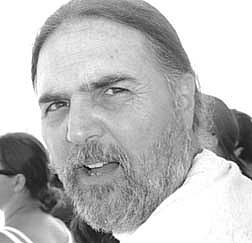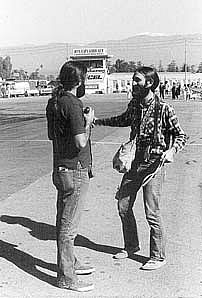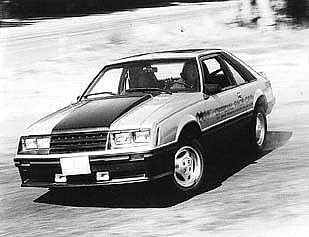|
|
|||
 |
|||
 When I called to console Ron Hussey's longtime companion, Annie Proffit,
she mentioned that Ron might've liked his ashes to be divided among the
late photographer's favorite race tracks. I nominated a couple of drag
strips.
When I called to console Ron Hussey's longtime companion, Annie Proffit,
she mentioned that Ron might've liked his ashes to be divided among the
late photographer's favorite race tracks. I nominated a couple of drag
strips.
Long-defunct Beeline Dragway, near Phoenix, is the place where I saw fear cross my friend's face for the first time. This would be the mid-1970s, when Hussey and I worked for sister-tabloids Motorcycle Weekly and Drag News, respectively. It didn't take long for the only two guys in the office with ponytails and country-rock cassettes to become buddies and travelling companions. A road trip to Arizona in the middle of winter was a natural.
Ron had never "shot top end" before, and required some assurance that there was no danger in standing 30 feet from Beeline's bent-up guardrail, just beyond the lights. After all, this was a fearless photographer already known for getting shots that were obtainable only by standing out in front of airborne motocross bikes and sideways Grand Prix cars. Hell, barely out of his teens, he'd survived two years in big-city jails! Surely this new friend could handle a harmless round of qualifying, insisted his companion -- an equally young, equally immortal reporter who had, after all, survived the explosive 1960s and '70s at outlaw strips without receiving a scratch. As luck would have it, the session had barely begun before some forgotten fuel car exploded its supercharger directly across from us. The boom was a big one, by any standard. So was the fire. My new pal hit the dirt, thrusting his trusty Nikon in the air. For a moment, it was so quiet down there in the desert that the only noise to be heard was the unmistakable tinkle of metal on metal: hot shrapnel falling out of the sky and striking the track's ambulance, parked 20 feet BEHIND us. If not instant religion, Hussey did acquire sudden respect for drag-racing photojournalism. Then he packed up his shit real quick, suggesting that we find a photo location about 1200 feet closer to the starting line. So, yeah, planting his ash in Phoenix would've been appropriate, if impractical. Doubtful whether I'd be even able to locate the former site of Beeline Dragway, let alone find and access that part of the Indian reservation that once bordered the finish line, Annie and Ron and I will have to settle for Pomona Raceway. NOTE TO RON: Ron Hussey and I lived in adjoining beach towns, Laguna and San Clemente, in a day when a struggling media type earning 200 bucks a week could afford to rent a decent house or, in my case, a small apartment with partial ocean view (looking out the bathroom window). Between 1976 and 1984, when I moved away, Ron and I would team up on editorial assignments ranging from event coverage to Malibu Grand Prix (for Motor Trend) and new cars (for Hot Rod). On his own, Ron shot dirt bikes, street bikes, land-speed-record attempts, Formula One, Indy cars, NASCAR, sports cars, fast airplanes, you name it. He also captured slower-moving stuff like eclipses and volcanoes for publications such as Sunset and National Geographic.
As a newspaper and magazine editor from 1975 to 1988, I saw virtually everyone's film. I used to say that Ron Hussey just might've been the finest 35-millimeter action photographer out there. Lots of people are saying much the same about Ron's subsequent work in digital photography. "Ron genuinely pioneered this area of photography," recalls Jim Thompson. "He literally laid down a lot of the principles still in use, especially in sporting environments." Thompson would know. The founder of CART's news service recognized Hussey's rare combination of raw talent and knowledge of photographic processes. In 1991, well before the word Internet was in common use, Thompson selected Ron to test a digital-photography system that Jim hoped would enable Hussey to capture Indy-car action as computer files -- then "modem" these fresh color images from any race track to daily newspapers and other publications around the world. Alas, initial testing was not promising. "We had a standard Nikon N90 camera body with a cord that ran to a backpack holding a full computer, including screen. It strapped to Ron's waist. It weighed 60 pounds. Ron tried, but he came back huffing and puffing, saying that this was never gonna work. He really looked hilarious, like a man from outer space wearing a moon-walker pack." The next evolution combined a digital back from Kodak with customized versions of either a Nikon N90 or Canon EOS body, using standard lenses. Each body carried the serial number 0001, according to Thompson. ("Whenever we called either company for service, we'd get a real long pause after we told them the serial number!") Thompson credits Hussey for solving a series of technical challenges.
|
|||
|
|||


